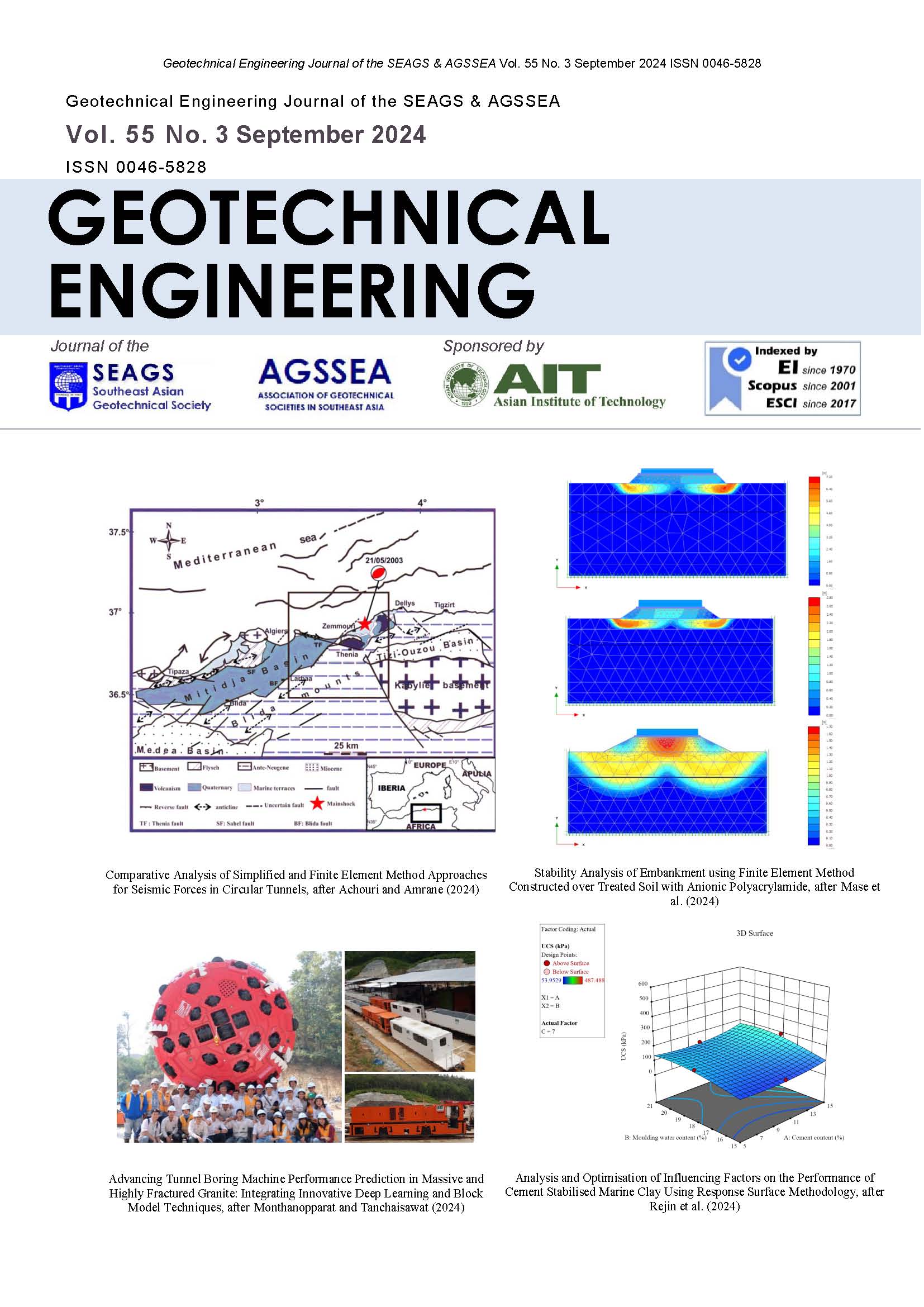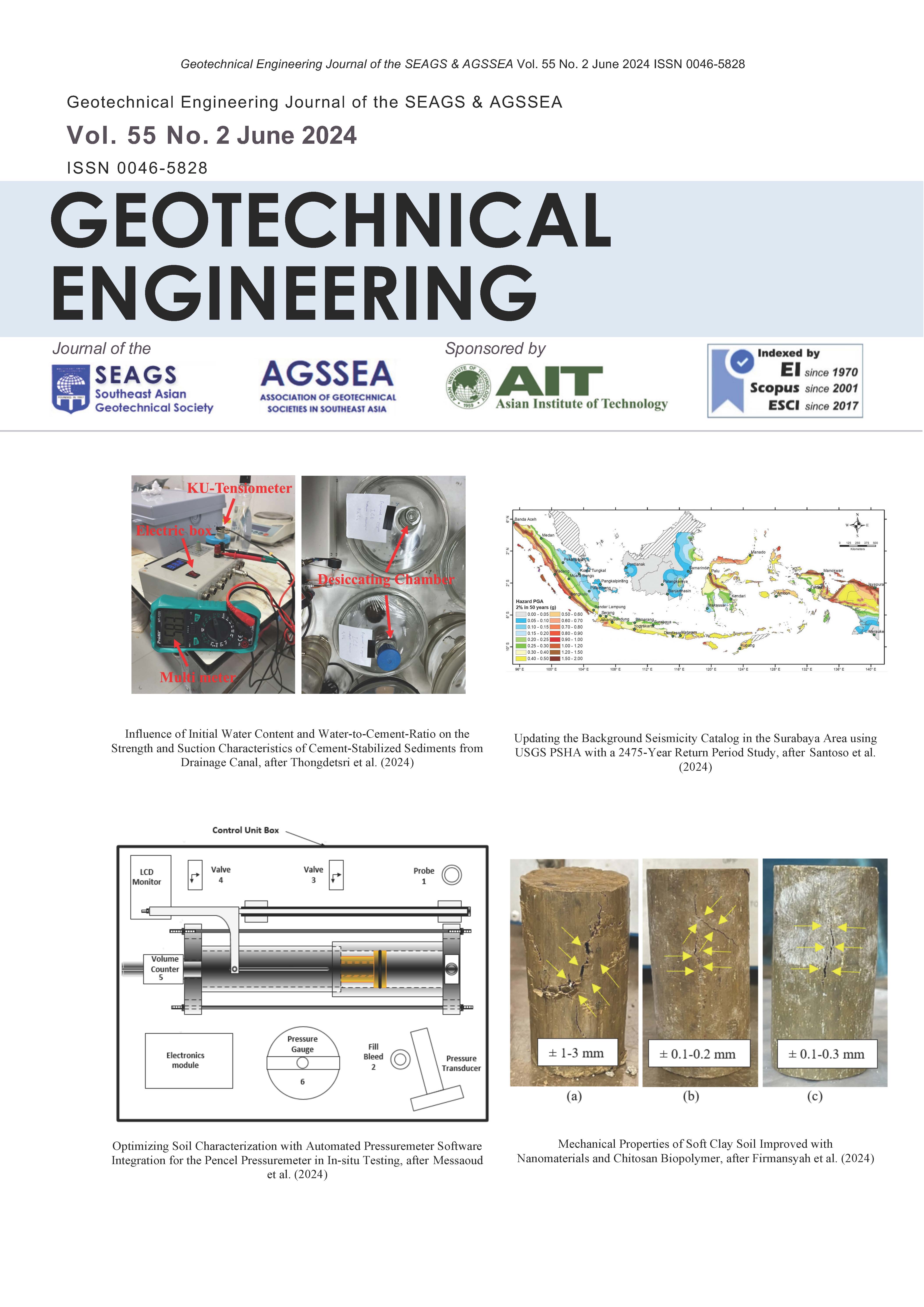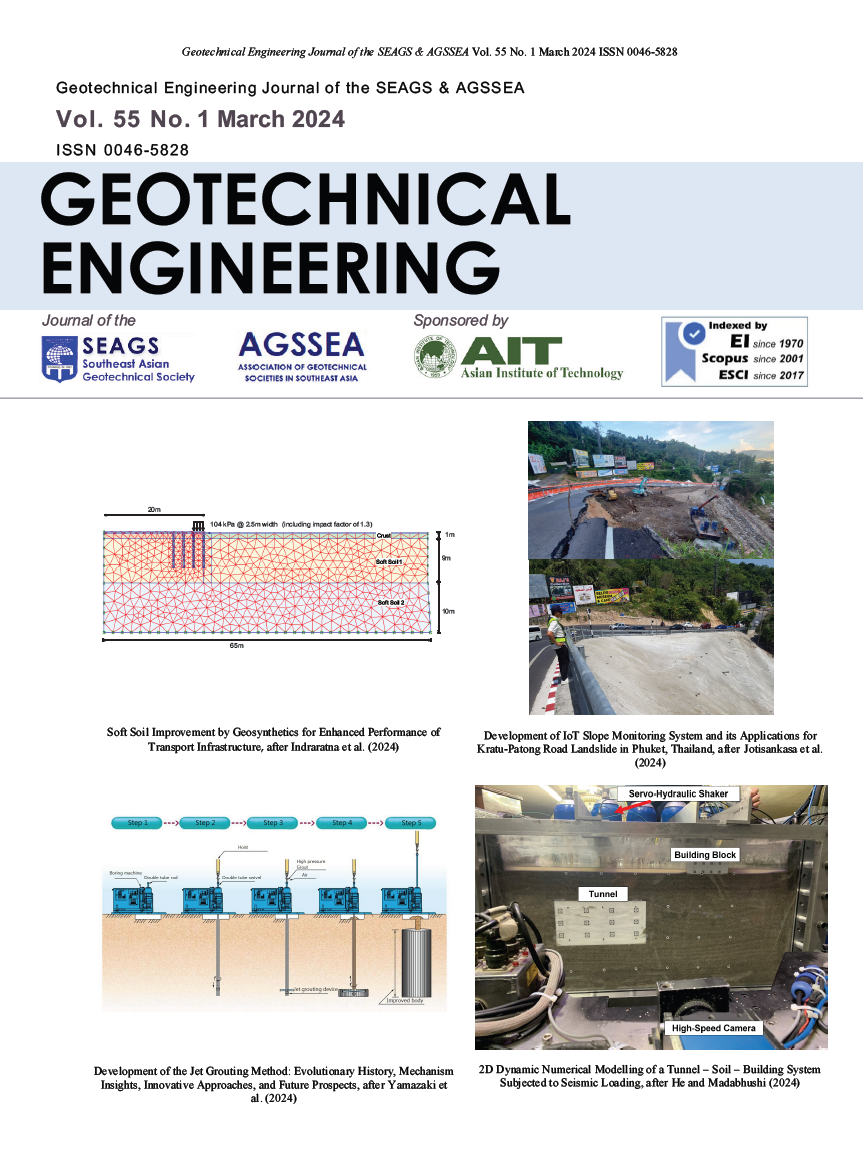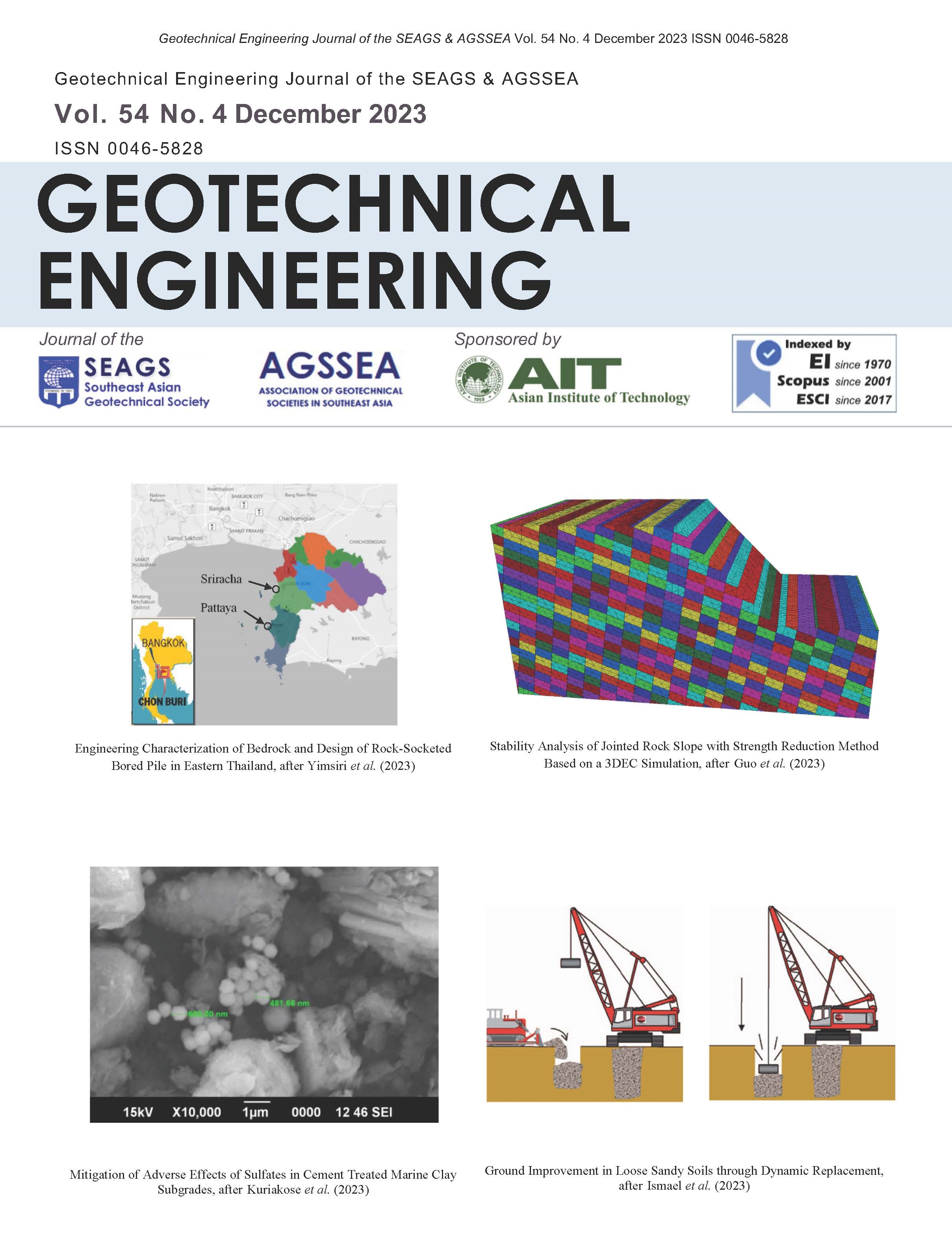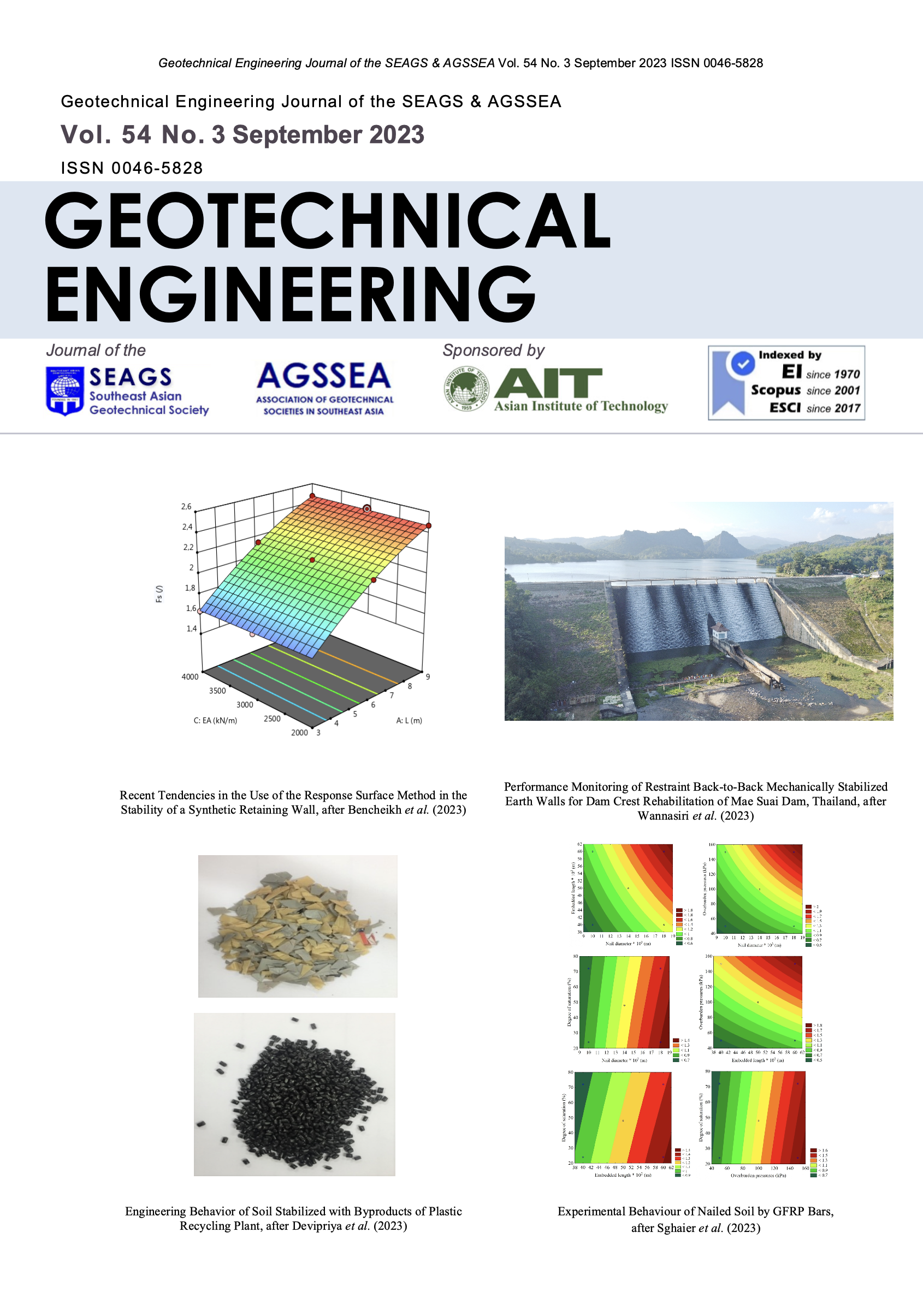Numerical Investigation of Passive Loads on Piles in Soft Soils
C. Moormann and J. Aschrafi
ABSTRACT: If piles are installed in slopes or next to heavy loads, especially in soft cohesive soils, piles are often loaded by horizontal ground displacements. In this case the pile shafts are stressed by shear forces and bending moments. Initially, a structured overview of existing analytical methods for estimating passive loading on piles by horizontal movement of surrounding soil is presented. While one component of passive load is determined by the shear strength of the soil, the other often negligible component depends on the relative velocity between the pile and surrounding soil. For mobilizing the maximum passive load on pile, the soil often has to undergo large deformations. In classical Lagrangian Finite Element Method these deformations distort the finite element mesh which might lead to inaccurate results or the numerical analysis does not converge to a stable solution. Hence, numerical study of pile soil interaction needs more sophisticated modelling techniques like the Arbitrary Lagrangian-Eulerian (ALE) method, the Coupled Eulerian-Lagrangian (CEL) method or the Material Point Method (MPM) to minimize numerical problems caused by distorted mesh. These methods are discussed briefly and their potential is shown for a simple 2D plane strain problem of a single passive loaded pile.
Numerical Simulation of an Energy Pile Using Thermo-Hydro-Mechanical Coupling and a Visco-Hypoplastic Model
Xiaolong Ma, Gang Qiu, Jürgen Grabe
ABSTRACT: Geothermal energy has been proven to be an economical renewable energy source and is applied all over the world. One of the efficient ways to use shallow geothermal energy is the thermal usage of piles. However, as temperature changes and the thermal expansion coefficients of concrete and soils are not the same, the interaction between them will be affected. In this article the thermal-hydromechanical (THM) behavior of an energy pile is simulated. The THM-coupling is implemented in the commercial software code Abaqus/Standard. The pore water pressure in the low permeability soils will be considered as they can have a considerable effect on the effective stress. A visco-hypoplastic soil model is used to reproduce the viscous behavior including creep, relaxation and rate dependency of fine grained soils. The calculated temperature development, the pile head settlement as well as the shaft resistance will be compared to results of a field test. Furthermore, a simplified concept will be introduced to understand the behavior of the shaft resistance and strains of energy piles due to mechanical and thermal loads.
KEYWORDS: thermal-hydro-mechanical coupling, energy pile, Abaqus, thermal loading, pore water pressure
Numerical Studies on Dynamic Load Testing of an Open-ended Pipe Pile and a Case Study
L. Phan Ta, T. Matsumoto and H. Nguyen Hoang
ABSTRACT: This paper proposes a numerical approach using a matrix form with Newmark’s β method to analyse the phenomenon of the one-dimensional stress-wave propagation in an open-ended pipe pile with the aim of enhancing the reliability of the dynamic analysis. To verify the proposed method, first, the calculated results obtained from the proposed method were compared with those obtained from the rigorous continuum method FLAC3D, the conventional Smith method, and the theoretical solution. The calculated results obtained from the proposed method were in good agreement with those obtained from the continuum method FLAC3D. Second, static and dynamic load tests of a spun concrete pile in a construction site in Viet Nam were carried out. Wave Matching Analyses (WMAs) using the proposed method were conducted to derive a static load-displacement curve. The derived curve was comparable to that measured in static load test (SLT), indicating that the proposed method has high potential to predict the static pile response. Hence, the proposed method could be used as a practical alternative to the conventional SLT.
Performance of Piled Raft Foundation Subjected to Strong Seismic Motion
K. Yamashita, T. Hashiba, H. Ito and T. Tanikawa
ABSTRACT: This paper offers a case history of a low-rise building, located in Ibaraki Prefecture, supported by a piled raft in medium to dense sand underlain by over consolidated silty soil. To confirm the validity of the foundation design, field measurements were performed on the foundation settlement and the load sharing between the piles and the raft from the beginning of the construction to 80 months after the end of the construction. During the monitoring period, 44 months after the end of the construction, the 2011 off the Pacific coast of Tohoku Earthquake struck the site of the building. The peak horizontal ground acceleration of 3.24 m/s2 was observed in the neighbourhood of the building. Although the foundation settlement near the centre of the raft increased by 4 mm from the pre-earthquake value of 21 mm to 25 mm, no significant changes in the load sharing between the piles and the raft were found after the strong seismic motion.
Static Cyclic Load Tests on Model Foundations in Dry Sand
Y.S. Unsever, T. Matsumoto, S. Shimono and M.Y. Özkan
ABSTRACT: The behaviour of pile foundations under horizontal loading was investigated by static cyclic horizontal load tests on model pile foundations including single pile, capped pile (single pile with a small raft), 3-pile pile group, 3-pile piled raft and raft alone in dry model ground. In order to consider the dead load of the superstructure, vertical load was applied to the foundations before applying horizontal load. Vertical load tests on the model foundations were also carried out to understand and discuss the behaviour of the model foundations subjected to horizontal loading. The raft effect, the effect of vertical load and their influence on the behaviour of the model foundations were investigated. The piles were instrumented with strain gauges to measure bending moments, shear forces and axial forces. The results showed that the piled raft model settles only a half of the pile group, whereas the tilting of the raft for both model types is similar under same horizontal loading. Also, the maximum bending moment and its location along the piles differ according to the foundation type.
Axial Bearing Behaviour of a Model Pile in Sand Under Multiple Static Cycles
J. H. Hwang, Z. X. Fu , P. Y. Yeh, D. W. Chang
ABSTRACT: This paper designed and built a set of loading equipment for conducting model pile test. The cyclic axial load was manually applied in a displacement-controlled type. A fully instrumented aluminium model pile was designed with the outer and inner diameters of 18mm and 17mm and a length of 450mm. The thickness is only 0.5mm. The length to diameter ratio is approximately 25. Seven strain gauges were carefully pasted on the inner wall and a mini-type load cell was installed at the bottom of the wall. The sand specimens were prepared in a relative density approximately 70% and with a diameter of 40cm and a height of 60 cm. Two types of cyclic axial load were performed for both dry sand and saturated sand. The first applies the compressive load first and then applies the uplift load. This finished a compressive-tensile load cycle(C-T type). The same cycle was then repeated five times. The second applies the uplift load first and then applying the compressive load. This finished a tensile-compressive load cycle (T-C type). Each cycle was then repeated five times also. The measured load-displacement curves of pile head and the transfer curves of the pile shaft were analysed to deduce the characteristics of cyclic axial bearing behaviours. The focus was put on (1) the difference of the compressive and tensile bearing capacities; (2) the effect of the number of applied loading cycles; (3) the development of end bearing capacity with pile head displacement; (4) the unit friction distribution pattern along pile length. Based on the test results, some interesting phenomenon and conclusions are reported herein.
Seismic PBD of Piles from Monte Carlo Simulation Using EQWEAP Analysis with Weighted Intensities
D.W. Chang, Y.H. Lin, H.C. Chao, S.C. Chu and C.H. Liu
ABSTRACT: This paper discusses the seismic performance based design (PBD) analysis on piles using one-dimensional stress wave equation and Monte Carlo Simulation. Seismic responses of the piles were monitored at a wider spectrum of earthquake intensities rather than the target ones. To obtain appropriate estimations, weights of the intensities were calculated from the probability density function solvable from the seismic hazard curve. Probabilities of failure of the piles were evaluated for uncertainties of soil parameters and seismic records, and then calibrated with the weights. The result of the numerical study indicates that the seismic force is the most dominant factor. Large diameter pile will exert cracks around pile head under moderate earthquakes. Therefore assessment based on only the pile head would become very critical. For design and maximum consideration (MCE) earthquakes, the piles were found satisfied because of performance required on ductility resistance and ultimate moment capacity. Probabilities of failure of the piles were also found sensitive to horizontal load from the superstructure. Comparing the correspondent reliability indexes with those required for acceptable foundations, the seismic performance of the piles can be assessed. With the suggested factor of safety, the seismic performance of the piles was found to be 1.1~2.2 for design and MCE quakes in this study.
Case Studies on Response of Laterally Loaded Nonlinear Piles
Wei Dong Guo
ABSTRACT: Closed-form solutions for laterally loaded free and fixed-head piles in elastic-plastic media have been developed and implemented into a spreadsheet program called GASLFP. Underpinned by a generic limiting force profile (LFP), the solutions offer an expeditious and sufficiently accurate method for predicting response of lateral piles. They also allow parameters to be deduced using measured pile response, as is evident in the study to date on ~70 test (elastic) piles. The solutions also well capture the impact of structure nonlinearity of pile body by employing reduced pile bending stiffness (EpIp). The law of the reduction in EpIp, however, needs to be verified. In this paper, the solutions are utilised to examine the response of four test-piles exhibiting structural nonlinearity. For each nonlinear concrete pile, the shear modulus of soil and the three parameters (of Ng, αo and n) for constructing the LFP were deduced first using elastic pile assumption; and subsequently the variations of flexural rigidity with bending moment, the cracking moment Mcr and the ultimate moment Mult were back-figured against measured pile deflection. The study provides parameters for modelling nonlinear piles in sand and clay, and justification on using pertinent expressions.
Numerical Analysis of the Effect of Pile Tip Shape on Soil Behavior around Pile
Y. Wu and H. Yamamoto
ABSTRACT: Underreamed (enlarged-base) piles are commonly employed in engineering practice. The pile tip is often made into different shapes. This study analyzes the effects of various underreamed pile tip shapes on the soil behavior around the pile. A finite element analysis combined with a mixed incremental method for the updated Lagrangian method is presented using a small strain formulation to solve the large deformation problem. Constitutive model for sand with particle crushing and joint elements are used to represent the behavior of sand around the pile and the interactive surface between the sand and the pile. The predicted relationship between the normalized bearing stress and displacement are compared with experimental measurements, showing good agreement. The numerical results demonstrate that the distributed area of the high-value radial stress contour and the high-value vertical stress decrease as the pile tip gets sharper. The distributed areas of the high positive-value vertical strain, the high negative-value radial strain and the high negative-value circumferential strain expand as the pile tip gets sharper. The numerical results clearly indicate that the soil beneath the pile tip at different depths displays various volumetric changes and confirms the necessity of the constitutive model for sand with particle crushing.
KEYWORDS: Model pile, particle crushing, large deformation theory, joint element, pile tip shape
Shaking Table Test on Superstructure-foundation-Ground System in Liquefiable Soil and Its Numerical Verification
F. Zhang, R. Oka, Y. Morikawa, Y. Mitsui, T. Osada, M. Kato and Y. Wabiko
ABSTRACT: In this paper, the effect of seismic enhancement on group-pile foundation with partial ground improvement method is investigated with shaking table tests and soil-water coupling dynamic elastoplastic finite element analyses. Model tests on a superstructuregroup pile foundation-ground system were conducted with the shaking table test device in which the liquefaction of sandy ground is considered. The model pile is made from aluminium and the model ground is made from Toyoura Sand. The model ground is carefully prepared with in-water sedimentary method. Different patterns of the partial ground improvement for an existed group-pile foundation are investigated in the tests and numerical analyses. In the analyses, nonlinear behavior of the ground and the piles are described by the cyclic mobility model (Zhang et al, 2007&2010) and the axial force dependent (AFD) model proposed by Zhang and Kimura (2002) that can take into consideration the axial-force dependency in the nonlinear moment-curvature relation. The applicability of the numerical analysis using the program named as DBLEAVES (Ye et al, 2007) has already been confirmed in previous researches that can be referred to relevant references. It is found that the effectiveness of the partial ground improvement method has been proved by both the shaking table tests and the numerical analyses.
Model Loading Tests on Bearing Behaviour of a Group Pile and Ground Deformation in Sand
S. Aoyama, B. Liu, L. Danardi, W. Mao, S. Goto and I. Towhata
ABSTRACT: Model loading tests were conducted in dry sand to investigate the mechanism of pile-soil-pile interaction under group pile loading. The group pile was constituted of 9 (3×3) closed-end piles when the spacing between pile centres were 2.5 times of the pile diameter (2.5D) and 5.0 times (5.0D). The results showed that (1) yielding settlement of 2.5D group pile was larger than that of 5D group pile, (2) the subgrade reaction of the 2.5D group pile became less than that of the 5.0D group pile or a single pile when the load-settlement relationship was linear; (3) subgrade reactions of 2.5D and 5.0D group pile became similar after yielding of bearing load. Ground deformation was studied using with visualising tests and PIV analysis. It was shown that the ground deformation occurred as a block in case of 2.5D group pile and the deformed area expanded deeper as compared with 5.0D group pile. This mode of ground deformation reduced the subgrade reaction in 2.5D group pile.
KEYWORDS: Group Pile, Model test, Vertical Load, Visualizing
Numerical Study on the Bearing Behaviour of Pile Groups Subjected to Lateral Pressure Due to Soil Movements
O. Reul, J. Bauer and C. Niemann
ABSTRACT: In soft soil layers vertical piles are frequently loaded laterally by horizontal soil movements caused by eccentric loading or unloading of the ground surface around the piles. In the course of the construction process of a steel mill a large scale test was carried out to investigate the influence of a storage for steel slabs on the pile foundation of a neighbouring bridge crane. In the scope of this paper the results of the measurements carried out during the large scale test are compared with three dimensional, coupled pore pressure-displacement finite element analyses investigating the influence of a thin stiff layer within a deposit of soft soil and the roughness of the pile-soil interface on the lateral pressure acting on the piles.
Deep Foundation Systems for High-Rise Buildings in Difficult Soil Conditions
R. Katzenbach and S. Leppla
ABSTRACT: The economic and environment-friendly design of deep foundation systems focuses on a reduction of construction material used, construction time spent and energy consumed within the buildings construction and service time. The special foundation system Combined Pile-Raft Foundation (CPRF), in-situ load tests on the construction yard and a sufficient soil investigation allow cost optimized constructions. In any case at challenging projects the observational method has to be applied for verification and quality control of the design. Regarding the 4-eye-principle as basis of the quality control management an independent peer review of the planning, design and construction phase is the guarantee for safety, serviceability and optimization of all projects. Optimization processes combined with a necessary quality management are explained in this paper on several challenging projects from engineering practice.








